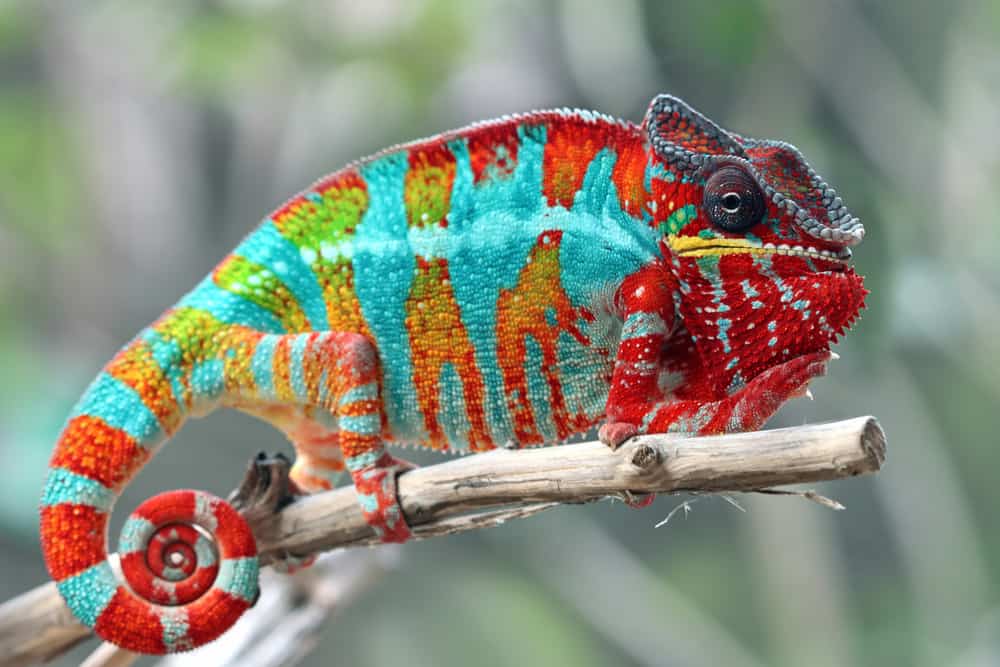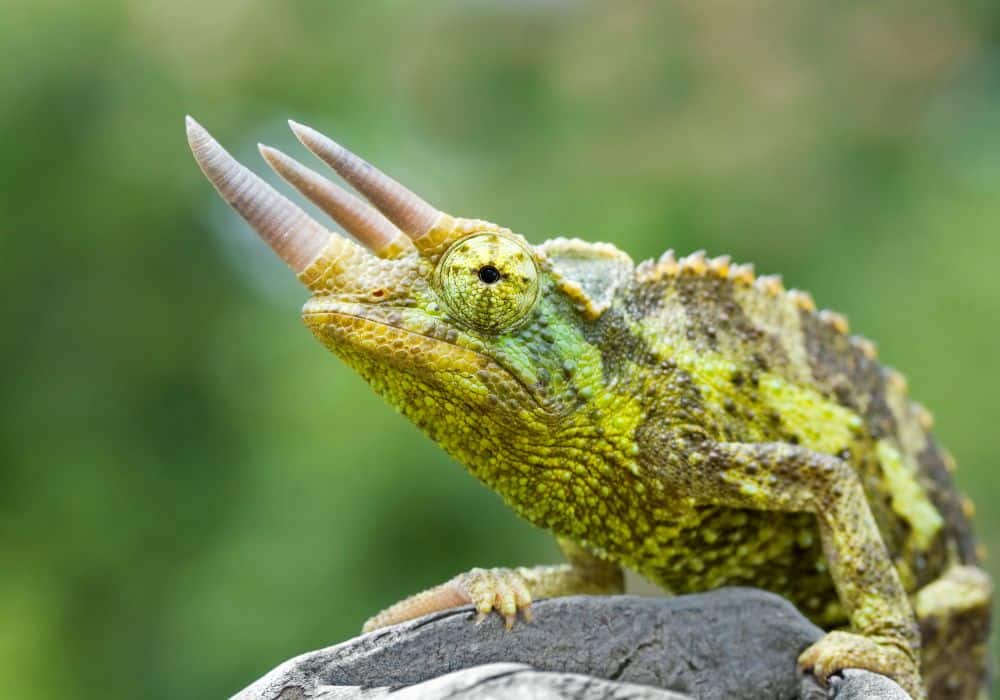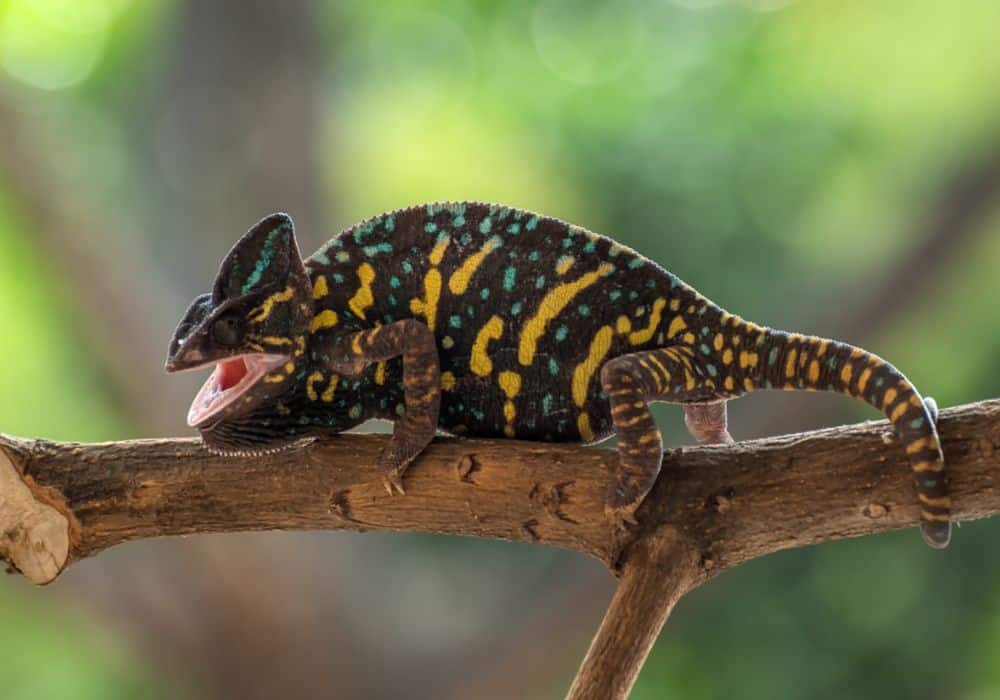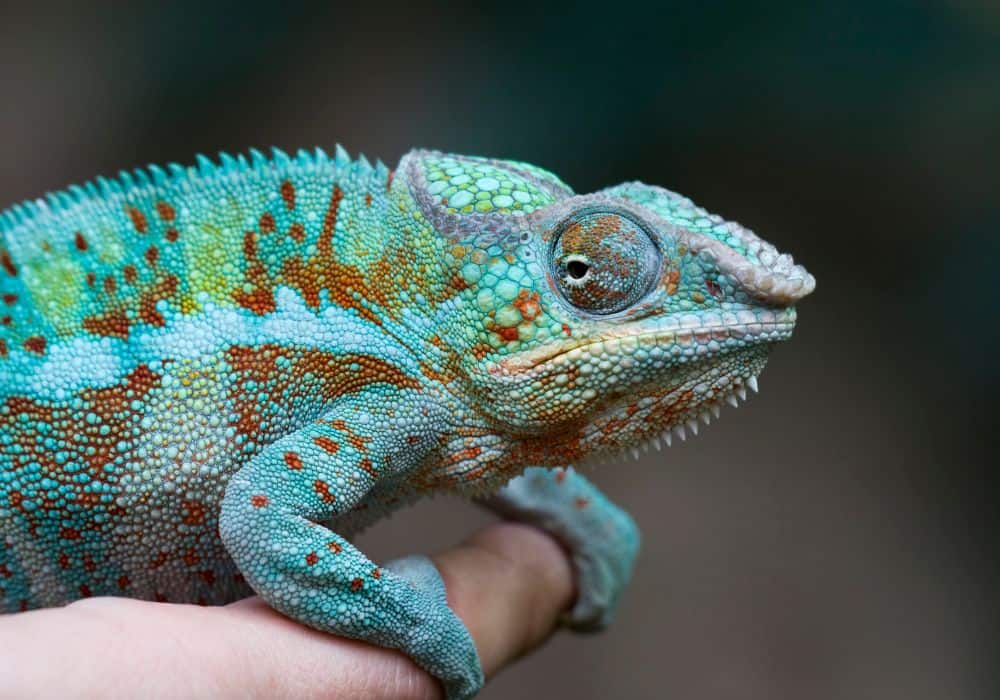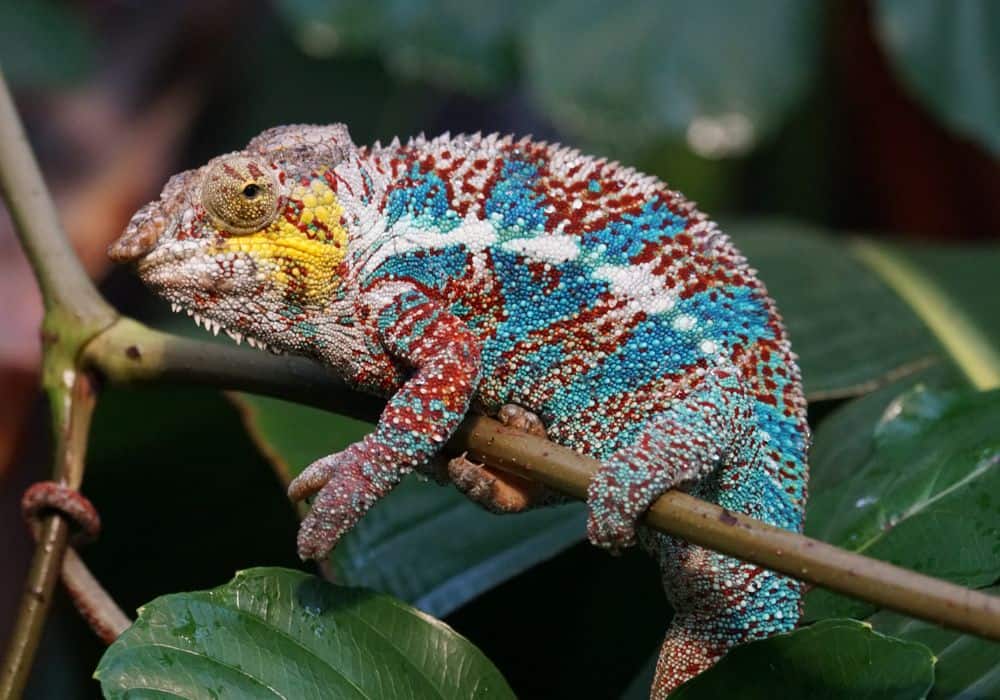Chameleons are a type of reptile that mainly live in rainforests and are famous for their unique color-changing attribute. These lizards make for exciting pets, but there are a few things you should know about chameleons before you get one.
A couple of common questions about chameleons include: “What kinds of chameleons are there?” and “How to identify a chameleon?”
Once you’ve read about these topics, you might wonder, “What do chameleons eat?”
Interesting Facts About Chameleons
According to San Diego Zoo, there are over 158 known species of chameleons worldwide. While you may think these colorful reptiles only live in Africa, chameleons live in many parts of Asia and Europe.
Veiled Chameleons have settled in Florida even though their original habitat is in Yemen and Saudi Arabia.
As reptiles, chameleons lay eggs to reproduce. However, some species of chameleon instead give birth in the way that mammals do. The number of offspring varies from type to type and spans anywhere from two to one hundred baby chameleons.
How To Identify A Chameleon
You can identify a chameleon by its spherical, dome-shaped eyelids and small pupils that turn in all directions. The eyes of a chameleon are unique to their species, as they can turn their eyes in entirely different directions from one another. Chameleon eyes can see about 360 degrees around their body, making for a tremendous advantage in capturing prey.
A long, sticky tongue helps chameleons catch prey from a distance, sometimes more than its body length. Chameleon tongues are action-packed, meaning their tongues can swiftly catch prey even though the reptiles themselves are slow creatures.
A chameleon’s feet help grip better while climbing to great heights in their natural habitats. They have five toes that function as our hands grab onto branches and pull themselves up.
Chameleon tails are prehensile, which means they can grab onto objects in their surroundings for support. Having a prehensile tail is a feature chameleons share with monkeys as well.
Last but not least, a chameleon’s single most defining feature is its color-changing ability. These reptiles can change color not by a miracle but by pigments underneath their outer layer of skin. Color changing is controlled by signals that the chameleon’s brain sends to the skin cells, often determined by mood or hormones.
Different Types of Chameleons
Jackson’s Chameleon
The Jackson’s Chameleon is widely known for the male of the species to have three horns upon its head. You can compare this chameleon’s head to that of a Triceratops, which is one of the reasons it is highly likable as a pet, besides being very resilient. I also want to point out that the female Jackson’s chameleon is one of the few chameleons to give live birth instead of laying eggs.
Veiled Chameleon
This type of chameleon can grow anywhere from 18 inches to 2 feet long, making them one of the more significant domestic types of chameleons. These chameleons make for popular starter pets and live from 4-8 years. These reptiles are best known for their bright colors and crested head.
Panther Chameleon
The Panther Chameleon is a more vibrant type that lasts 2-7 years. You will notice that these chameleons shift color to display mood as well as regulate body temperature. Panther chameleons are famous for their bright colors, but they are territorial so keeping one alone is ideal.
What Do Chameleons Eat?
Chameleons are omnivores, meaning they eat both “meat” (in this case, primarily insects) and plants.
A chameleon’s diet typically includes a wide variety of insects and vegetation. Chameleons eat fruits, vegetables, insects such as locusts, or leafy greens in the wild. In captivity, you may feed your chameleon some common foods such as mealworms or Dubia Roaches.
Chameleons will eat mealworms, waxworms, super worms, silkworms, Dubia roaches, house crickets, locusts, and more. Your pet chameleon will also enjoy apples, pears, melons, blueberries, squash, zucchini, bell peppers, mustard greens, collard greens, spinach, and more.
To keep their diet healthy, pet chameleons should be fed gut-loaded insects. As explained by Dubiaroaches.com, gut loading is the process of feeding or “loading” insects with essential vitamins to ensure your pet gets the nutrients it needs. You can use unique gut load products or fresh produce for this process.
A few examples of fresh produce for gut loading are apples, alfalfa, carrots, dandelion, kale, mustard greens, spinach, and more. Anything that will add nutrition to the feeder insect will add nutrition to your chameleon.
Gut-loading feeder insects can provide the added vitamins your chameleon needs in its diet. You can also dust your feeder insects with calcium supplementation before feeding them to your pet. Calcium supplementation helps keep your lizard healthy and maintains its natural gut health if used alongside gut loading.
Maintaining a proper diet with gut loading, calcium dusting, and fresh vegetation is crucial to raising a healthy chameleon.
What Is A Chameleon’s Favorite Food?
You can feed your chameleon many insects, fruits, and vegetables… But what are chameleons’ favorite food?
Depending on the type of chameleon, it will likely have a favorite insect treat. According to Cuteness.com, silkworms and waxworms make up most of the chameleons’ favorite foods. However, they shouldn’t be anything more than a treat because those worms won’t provide a nutritious diet on their own.
How Do Chameleons Hunt?
One of the features you can quickly identify in chameleons is their long tongue. These exotic reptiles rely on their excellent vision and reflexes regarding hunting. Their tongue can be longer than their body and serves as a grabbing tool for catching prey.
A chameleon’s tongue is equipped with muscle at the tip and is sticky enough to snatch up insects. Naturally slow, these reptiles have surprisingly quick reflexes when they spot their next meal. Their tongue allows them to pull prey right into their mouth, where they will then chew it up with their strong jaws.
Some chameleons will even hunt small birds or mice in their natural habitat.
When keeping a chameleon as a pet, you should allow it to hunt for its meals. Chameleons will eat live feeder insects like they would in the wild. This provides enrichment to your pet chameleon and keeps it active.
How Do I Care For A Chameleon?
You will need to house and care for your chameleon with special equipment. Most chameleons are territorial and should be kept alone or apart from other chameleons.
When housing your new pet, consider the width of your chameleon. According to Topflightdubia.com, a 2x2x4 feet cage will suit your adult chameleon nicely. If you pick a cage that is too small, it will put stress on your pet.
Another thing to consider is that chameleons need a steady airflow in their living space. Ensure the cage has two or more screens that allow for the necessary air. Should your chameleon not have the airflow it needs, it may suffocate or develop severe health conditions.
Chameleons are used to rainforest and desert conditions. Having a basking lamp and keeping temperatures regulated is super important. Make sure your exotic lizard has a cooler and warmer spot inside its home.
Providing plenty of live vegetation and branches for your chameleon friend to climb will improve its quality of life. Make sure to mist your pet’s cage 2-3 times daily, with breaks in between. This way, your chameleon will feel at home in its simulated jungle.
Having a UVB light will allow your chameleon to be most comfortable. A UVB light simulates sunlight and provides your reptile with vitamin D, better calcium absorption, and overall health. Ensure your UVB light is positioned so your chameleon can bask underneath it like it would in the wild.
How Do I Know If My Chameleon Is Eating Enough?
Your chameleon’s diet is essential to its well-being, so ensuring it eats enough is a common worry. Chameleonacademy.com recommends feeding your juvenile chameleon as much as it can eat until adulthood. After adulthood, 2-3 food items may be provided to your pet chameleon every other day.
A good rule of thumb is if the food is around the size of your chameleon’s head, it is suitable for feeding. Feeding your chameleon insects or vegetation larger than its head isn’t the best idea as it may have trouble swallowing or digesting it. Instead, stick with foods you know can fit in its mouth.
If your chameleon is eating enough, it should fit the size and weight of its age range and species. Make sure to look into a healthy size for your male or female chameleon at the stage of life it is currently in.
Final Words
To wrap it all up, chameleons are omnivorous, color-changing reptiles. There are over 158 known species of chameleon, all of which are unique in their way.
Chameleons feast on many worms, roaches, crickets, fruits, and vegetables. These colorful reptiles also greatly benefit from gut loading and calcium dusting. When feeding your chameleon, you should consider its size and ensure not to overfeed it.
Kids and adults can enjoy these exotic lizards with the correct information and proper handling.
You now know what chameleons eat, their favorite food, how to care for them, and how to tell if they are eating enough.
Please comment if you have any questions!
Key Takeaways:
- Mealworms, waxworms, super worms, silkworms, Dubia roaches, house crickets, and locusts are some insects chameleons will eat.
- Apples, pears, melons, blueberries, squash, zucchini, bell peppers, mustard greens, collard greens, and spinach are some of the vegetation options for your c
- Gut loading and calcium dusting help improve your chameleon’s nutrition and health.
- Chameleons need special living conditions that simulate their natural habitat.
